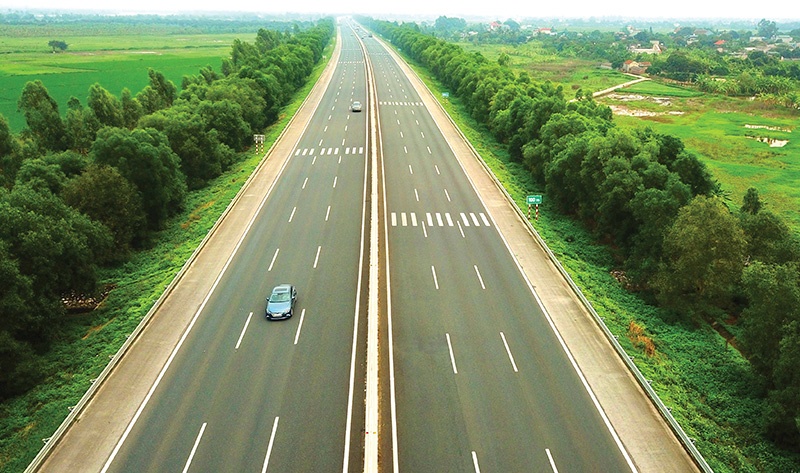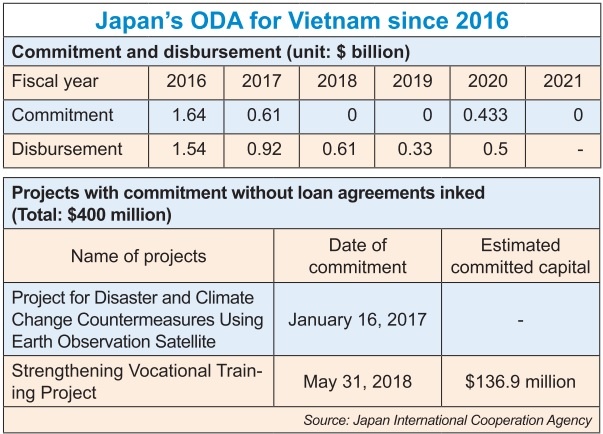Japanese committed to ODA infrastructure ventures
 |
| Japanese committed to ODA infrastructure ventures, illustration photo |
Shimizu Akira, chief representative of the Vietnam Office under the Japan International Cooperation Agency (JICA), said that Vietnam is boosting economic activities with a balance between infrastructure and human resources development, which plays a crucial role in economic recovery.
“However, Vietnam still faces bottlenecks in basic infrastructure. JICA will continue to support Vietnam’s socioeconomic development by implementing infrastructure projects under the policy of the Japanese government,” he told VIR.
JICA’s figures show that in the fiscal year from April 2020 to March this year, the total official development assistance (ODA) commitment for Vietnam amounted to $436.56 million; the technical grant stood at $38 million; and other grants sat at $18.6 million. The period saw about 100 projects funded by Japan in total.
Japan’s total financial support for Vietnam in infrastructure development, especially transport, is estimated to be over $10 billion so far. Many projects are in good progress.
 |
For example, workers at the six ramps of the Mai Dich-South Thang Long viaduct section are finishing the final works so that these ramps can be put into use in the coming time. The viaduct of Hanoi’s Ring Road 3 was funded by Japan’s ODA loan, and was officially opened in October 2020 to traffic after over two years of construction, helping to end chronic traffic jams in the area.
The project aims to construct a high-standard inner-city expressway in the western section, connecting the Mai Dich intersection and the South Thang Long intersection of Ring Road 3 which runs along the outskirts of the capital. The 5.34-km section has 4.8km of viaduct.
JICA and the Vietnamese government signed a loan agreement worth $195.48 million in 2013 to implement the project.
JICA has a long history of cooperation for the development of Ring Road 3 in Hanoi. Japanese ODA loans were provided for the Red River Bridge, the New National Highway 3, and the Regional Road Network.
In 2007, Thanh Tri Bridge connecting to Ring Road 3 was completed. After that, the northern and southern approaching roads of the bridge were opened to traffic in 2009 and 2010, respectively. Subsequently, in 2012, a 9-km section connecting the intersection of National Highway 32 with the northern side of Linh Dam Lake, which is the southwestern section of Ring Road 3, was opened to traffic.
Finally, in 2014, the section connecting Hanoi and the northern city of Thai Nguyen was also completed.
In addition to supporting Vietnam to implement projects such as new terminals of the Noi Bai and Tan Son Nhat international airports, and Lach Huyen seaport, JICA has also been carrying out projects to connect roads and bridges among localities, such as on the North-South railway and the Ke Nam bridge in the central province of Nghe An.
“About 70 per cent of Vietnam’s national roads have been built and upgraded with ODA from Japan. Completed projects have helped boost connectivity within ASEAN and facilitated the flows of goods and public travel. This has also helped localities attract more foreign direct investment,” said a JICA report released last week.
To help Vietnam achieve high economic growth amid a rise in population, JICA has also been deploying projects to improve people’s lives, involving power generation, expressways in urban areas, and water treatment facilities. Japan has helped Vietnam generate 10 per cent of the latter’s power output.
“Amid the COVID-19 pandemic, the Vietnamese government’s policy is to continue implementing public works while ensuring safety precautions for workers. The continuance of all JICA’s loan projects have sustained employment, thus contributing to support the economy,” Akira said. “On the other hand, infrastructure development is also very important for improving the domestic investment environment.”
For example, he said, in August, the Japanese-backed project to expand the Da Nhim hydropower plant was completed and has just been put into commercial operation. This plant’s construction was funded by Japan and became operational in 1964.
Earlier in May, JICA inked another deal to provide a loan worth $25 million for an onshore wind power project of 144MW in the central province of Quang Tri. The project’s investors are Vietnam’s Power Construction No.1 JSC and Japan’s RENOVA Inc. The borrowers include Vietnamese wind power groups such as Lien Lap, Phong Nguyen, and Phong Huy.
Meanwhile, the Ho Chi Minh City Urban Railway Construction Project, backed by Japanese ODA worth $1.58 billion, has resumed construction after a delay due to COVID-19. “I hope the project will soon become operational,” Akira said.
The Asian Development Bank estimates that Vietnam would need at least $16.7 billion per year on average for 2015-2025 to finance its infrastructure development needs. The World Bank forecasts up to $25 billion a year, much higher than the average level in 2011-2015.
What the stars mean:
★ Poor ★ ★ Promising ★★★ Good ★★★★ Very good ★★★★★ Exceptional
 Tag:
Tag:
Related Contents
Latest News
More News
- Global partnerships key to Vietnam’s IFC development (December 26, 2025 | 16:18)
- Vingroup pulls out of bid to invest in North-South high-speed railway (December 26, 2025 | 11:42)
- Strengthening supply chains through trade promotions and customs reform (December 24, 2025 | 14:00)
- PM orders investment model for North–South high-speed rail (December 22, 2025 | 17:43)
- LS Eco Energy to invest in Vietnam rare earth sector (December 22, 2025 | 17:31)
- Government moves to establish International Financial Centre (December 21, 2025 | 21:00)
- Vietnam's IFC to target global investment flows (December 21, 2025 | 18:00)
- Two national hospitals expand capacity with new facilities (December 20, 2025 | 09:00)
- Ha Tinh breaks ground on major Vingroup industrial and energy projects (December 19, 2025 | 18:24)
- EVN launches major power infrastructure projects nationwide (December 19, 2025 | 18:17)






















 Mobile Version
Mobile Version